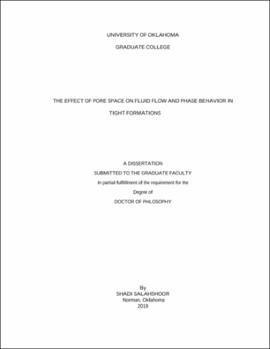| dc.description.abstract | Unconventional resources have led to a new abundance of natural oil and gas supply all over the world over the past decade and are expected to play a vital role in the future of this industry. Despite tremendous growth of extraction technologies which increased the production of these reserve significantly, knowledge and understanding of flow and phase behavior of the fluid in unconventional resources has remained insufficiently explored.
Accurate understanding of phase behavior of fluids trapped in the extremely small pores of these resources, especially shale reservoirs, is the center of attention for a lot of scholars globally. Although numerous mathematical and theoretical studies are available to explain phase behavior of confined fluids, limited number of studies attempted to explore this effect experimentally. Experimental data are invaluable in providing the deep insight needed to explain this effect, validate available models, and introduce methods of characterizations that would help with optimization of production plans.
The present work is an attempt to enhance the understanding of fluid phase behavior in tight formations through experimental investigations. Microscopic effects and their macroscopic consequences that plays a crucial role in adding to the complexity of fluid phase behavior in these reservoirs are explored and explained prior to discussing modeling and experimental works. Fundamental knowledge of phase behavior and thermodynamic principals that are essential for exploring this effect and for comparing the shortcomings of established experimental approaches in phase behavior studies of conventional reservoirs are covered. A thorough review on the existing theoretical and experimental studies on the topic, considering their results and predictions, is conducted to shed more light on the need for further experimental investigation of phase behavior alterations in tight gas condensate formations.
Isochoric method is an indirect high-precision way of phase transition point determination which is commonly used in other disciplines where a clear non-visual determination of phase transition of a fixed volume of fluid is needed. The present work provides an insight into using this approach in determining dew pint pressure (DPP) for gas mixtures inside and outside of the porous media. A semi-automated apparatus for measuring and monitoring equilibrium conditions along with fluid properties is designed based on the isochoric method. The apparatus provides constant volume, variable pressure (0 to 1500 psi), and variable temperature (290 to 410 K) experimental conditions. Pressure and temperature measurements are used to detect the phase transition point along the constant-mole-constant-volume line based on the change in the slope of this line at the transition point. A packed bed of BaTiO3 nanoparticles, providing a homogenous porous medium with pores of 1 to 70 nm is used as a representative nano-scale porous medium. The synthesized porous medium is very helpful in uncoupling the effect of pore size from the effect of mineralogy on the observed deviations in behavior, providing a volume more than 1000 times larger than typical nano channels.
The result is a set of Isochoric lines for bulk and confined sample, plotted on the phase envelope to demonstrate the change in saturation pressure. Phase envelopes (P-T diagrams) of the same mixture using different equations of state are constructed and the accuracy of each of these equations of state in providing an experimentally detected DPP is discussed. Many attempts in explaining the shift in saturation pressures of the reservoir fluid confined in the narrow pores of unconventional reservoirs compared to those of the bulk can be found in the literature. However, there are some contradictions between the predicted behavior using different mathematical approaches. Experimental data could be substantially helpful in both validating models and improving the understanding of the fluid behavior in these formations. Contrary to what many published models predict, the results of the present work show that confinement effects shift the DPP towards higher values compared to the bulk for a fixed temperature in the retrograde region. In the non-retrograde region, however, this shift is towards lower dew point pressure values for the confined fluid compared to the bulk. Capillary condensation is identified to be the main source of the deviations observed in the behavior of fluids inside nanopores. We evaluated published models, including those based on EOS modifications, by comparing it to experimental results to provide a quantification of their accuracy in estimating saturation pressure values for the confined mixture. Future applications of the present work for directing it towards an all-inclusive theory for all reservoir fluids in unconventional formations are clearly outlined.
| en_US |
